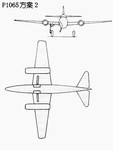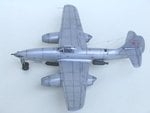kool kitty89
Senior Master Sergeant
But when P-47s were fitted with external tanks in mid '43 it increased their range enough for escort duty. P-38s already had the range needed for escort, but were needed in the Pacific and didn't enter Europe in large numbers until early '43.
The P-47 also had more development potential as seen in the XP-47J and XP-72 which had top speeds over 500 mph (the XP-72 managed 480 mph at Sea Level) and these figures are better than those of the Super Corsair (which had numerous other problems), but the Thunderbolt variants would still be less agile. The P-72 would have been a good intrim measure for jet-fighters as it was ready for production in early '44
The USAAF had even placed an order for the P-72, but this was cancelled because there was more of a need for escort fighters, like the P-51, not interceptors (which was a major purpose of the P-72). The P-72 would have made a good escort fighter with external tanks, and the range could have been further improved (as well as maneuverabillity) if the P-47N's wings had been fitted to it. (So I'm not sure why an escort varient was not considdered)
With ample speed, excelent armour, and good high-altitude performance, the P-72 would have prooved a stuborn opponent aganst the Me-262.
Though not superior, the craft would still have bridged the speed gap that was the 262's main advantage, and the P-72 had a 6000 ft ceiling advantage, but the 262 would probably have been much more agile, especially at high speeds. This is ofcourse assuming that the P-72 was no more manuverable than the P-47 and that it didn't sport the squared-off wing-tips of the P-47N (which improved roll).
The P-47 also had more development potential as seen in the XP-47J and XP-72 which had top speeds over 500 mph (the XP-72 managed 480 mph at Sea Level) and these figures are better than those of the Super Corsair (which had numerous other problems), but the Thunderbolt variants would still be less agile. The P-72 would have been a good intrim measure for jet-fighters as it was ready for production in early '44
The USAAF had even placed an order for the P-72, but this was cancelled because there was more of a need for escort fighters, like the P-51, not interceptors (which was a major purpose of the P-72). The P-72 would have made a good escort fighter with external tanks, and the range could have been further improved (as well as maneuverabillity) if the P-47N's wings had been fitted to it. (So I'm not sure why an escort varient was not considdered)
With ample speed, excelent armour, and good high-altitude performance, the P-72 would have prooved a stuborn opponent aganst the Me-262.
Though not superior, the craft would still have bridged the speed gap that was the 262's main advantage, and the P-72 had a 6000 ft ceiling advantage, but the 262 would probably have been much more agile, especially at high speeds. This is ofcourse assuming that the P-72 was no more manuverable than the P-47 and that it didn't sport the squared-off wing-tips of the P-47N (which improved roll).








